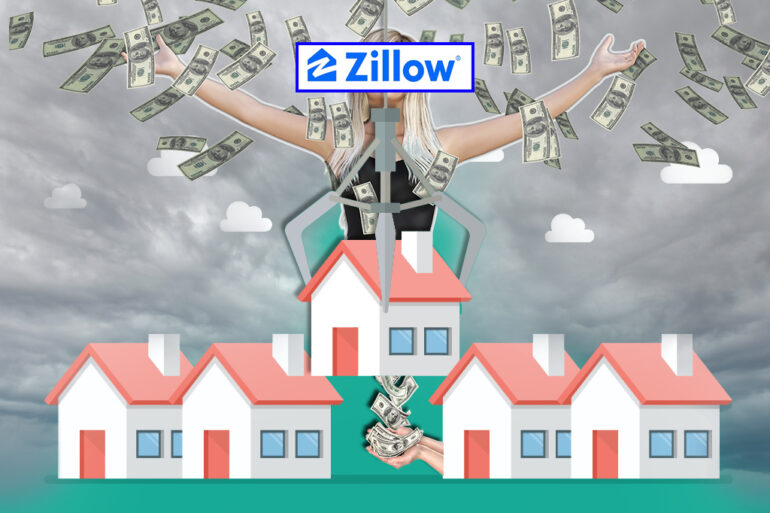Zillow was Never a Threat, Here’s Why!
Back where I come from in the UK, there’s a great saying: “Stick to your knitting.” This roughly translates to “American” as “Do what you know how to do and don’t stray too far from that.”
This is something that Zillow decided not to do, which has deeply impacted their shareholders and the 2,000 employees they are letting go over the next few weeks.
Zillow’s New Reality
Along Zillow’s new odyssey of allegedly buying nearly 18,000 homes since 2018, Zillow managed an average loss of $56,000 on each. That takes some doing; most, if not all, of us would be finished and out of the game after a few attempts with those results.
It also turns out that 70% of the homes Zillow purchased are now worth less than what Zillow paid for them.
That’s not because the housing market is decreasing; that’s just because Zillow’s wonderful algorithm made them overpay!
Making losses in the housing market is hard to understand when (generally across the United States) the cost of single-family homes has risen on average 19.9% year on year up until 2021. The conservative Fannie Mae predicts a 7.9% growth in prices in 2022.
This prediction is supported by most of the ‘in the know’ experts and institutions.
Like all of us, I have looked on the large, publicly funded behemoths such as Opendoor, Offerpad, and, until recently, Zillow with some curiosity and envy.
And then I got to thinking. The simple fact is no matter how great your algorithm is and whether it’s underpinned with artificial intelligence, nothing beats walking through the front door of a potential deal. You can use your own eyes to assess the state of the property and what it will take in time and money to get it into market-selling condition.
Should iBuyers Worry Real Estate Investors?
In the short term, it could be argued that some iBuying companies will take away opportunities from individual flippers, especially when they’re overpaying for real estate. My long-term view, however, is that all will fall by the wayside, weighed down with debt.
Who knows better than a local real estate investor/rehabber how a particular local market is performing, where to find real hot areas, and which properties across the railway tracks you shouldn’t touch with a ten-foot barge pole.
I think we are far from a computer that can outthink a human brain rationally.
No current algorithm with artificial intelligence will replace us, especially if it gathers information from number crunchers and not on-the-ground real estate professionals.
According to Bank of America, the average selling price of a cross section of homes that Zillow purchased in 2020 was 2% less than the purchase price! Less than!
It is no wonder that Zillow reported last month (October 2021) that it had reached its homebuying capacity.
In 2021, Zillow reported a third-quarter earnings loss of $339.2 million, compared to $39.6 million profit the corresponding year.
These losses would have been more significant in a stagnant or corrective real estate market, so I’m guessing Zillow has decided to bow out disgracefully while the market is still hot rather than face horrific losses in the future by hanging on. That could destabilize Zillow’s ability to continue as a company in its current and more recognizable guise.
Thank heavens they have healthy cash flow due to the immense amount of advertising they generate from their regular business, but let’s be straight, this is a significant body blow to Zillow.
Their market cap fell from $50B to $17B. I don’t care where you come from; that’s a lot of money to be out!
A major contributing factor to the failure of Zillow’s business is the rise of material costs and a labor shortage, which hikes the cost of labor, all due to COVID-19, but that’s another story. By the way, just as a minor tangent to this article, the shortage of labor means the available labor is probably substandard, which brings other obvious predicaments.
Lately, the supply chain issue has taken bites out of us all. We have seen lumber accelerate to 150% of the price 18 months ago.
No algorithm in the world will be flexible enough to incorporate these calculations into its offer price to a homeowner.
However, only 10% of all offers made by Zillow to homeowners were accepted, which is quite counterintuitive to an aggressive market valuation.
This means that, over time, Zillow altered their algorithm to increase their offers to improve their buying success rate. Well, we know now how that worked out — Zillow was screwed and double screwed.
Investors Have a Big Advantage Over iBuyers
OK, very interesting, but how will all this affect you moving forward?
In my opinion, it won’t.
Zillow will try to recover as much of their losses as possible by selling at as close to market price as they can.
Zillow won’t want to incur further losses by discounting — their shareholders would go into a frenzy if they did that. But a good friend of mine who is close to the situation told me some cash buyers are being invited to evaluate some of their inventory. Still, he added, these are not large venture-backed firms, just individuals and small investment businesses on a localized basis.
There are 9,800 houses allegedly in Zillow’s inventory. You have to remember that this portfolio is spread across the United States. To put this into context, 7.1 million homes were sold across the whole real estate spectrum in 2021, so let’s not get all concerned about Zillow flooding the market even if they did decide to follow an unlikely route of discounting.
I now call on over 40 years of experience in the real estate industry spanning three continents, four countries, and more cities than I care to remember.
Whatever the market condition, I always return to my favorite sport, the county foreclosure auctions.
Some report that the county foreclosure auctions are as competitive as they have ever been. Some of the best deals I’ve ever done at the county foreclosure auctions have been in highly competitive markets.
There is a deal hiding in every county foreclosure auction; you just have to know how to find it, and no fancy-shmancy algorithm is going to help you. Just your experience, local knowledge, and your keen eye will make you the dollars.
No algorithm is going to search PropertyOnion.com’s off-market database (I know, I know, but I love, respect, and trust our data), look for a suitable genre of real estate in a specific geographical location, compare it to others that are available, research it, drive by it, estimate the ARV and the cost to put it into saleable condition, factor in all the anomalies and idiosyncrasies of the rehabbing, and then turn a profit.
Profitably flipping a house once is an achievement, and I would say doing it profitably 18,000 times is nigh on impossible.
And that’s your advantage, my friend.
Whether you have $10,000 or $10,000,000, there is space in the county foreclosure auction for all of us. Large-scale competition like Zillow with new and different ways of buying real estate comes and goes, but in my humble opinion, the county foreclosure persists.
Happy hunting.








